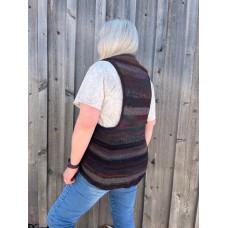| View or download a .pdf of this pattern |
|
Supplies: Cat Mountain Fiber Arts Fusion Yarn, two Fusion 800 Bundles, 3.75 mm /US Size 5 circular needle, 100 cm/36 inches or longer, six stitch markers, two additional removable stitch markers (or safety pins) of two different colors. Gauge: 6 Stitches/12 Rows = 2.5 cm/1 inch (after blocking) This yarn is available at www.yarngalleryonline.com. The sample was knit with the colorway Wood Nymph. The sample project and this pattern will fit a range of sizes, approximately Women’s Size 8 to 14. Possible sizing alterations are discussed at the end of the pattern. Cat Mountain Fiber Arts Fusion 400 (Fingering Weight) Before beginning, plan the sequence of skeins that you will use. This garment is knit in 10-row “ribs” of stockinette and reverse stockinette that are intended to show off the different yarns. It is suggested that you alternate skeins with different texture or appearance to emphasize the effect. Bodice With 3.75 mm/US size 5 circular needle, cast on 324 stitches using long tail cast on. Place stitch markers after every 54 th stitch, placing the last marker after the last stitch, then join in the round, being careful not to twist. You may choose to knit the first row or two flat, to make it easier to avoid twisting your work when joining in the round. In this case you would purl the even numbered rows until you have joined in the round. There are a lot of stitches so double check your work when joining to be sure it is not twisted! Place one removable stitch marker or safety pin through the knitted fabric (not on the needle) at the 54 th stitch, and one at the 216 th stitch, and leave these in place while knitting and slipping the other markers as your knitting progresses. These will mark where to begin picking up stitches for the back of the garment, and where to attach the back panel when it is completed. You should use two different markers of different colors (or perhaps tie a small piece of yarn on one of them) as you will need to make note of which one is which for use later in the pattern. Row 1: Knit, slipping all stitch markers Rows 2 – 9: Knit, slipping all stitch markers (join in round at the end of the second or third row if you have not already done so). Row 10: Knit to the last stitch before the stitch marker, knit in both the front and back loop (increasing by one stitch), knit the stitch before the marker, slip marker, knit in both the front and back loop of the next stitch (increasing by one stitch). Repeat around, increasing in each stitch before and after the stitch immediately before each marker (336 stitches). Break yarn and begin the next rib with an alternate yarn texture/type. Rows 11-14: Purl each stitch, slipping all stitch markers. Row 15: Purl to the last stitch before the stitch marker, purl in both the front and back loop (increasing by one stitch), purl the stitch before the marker, slip marker, purl in both the front and back loop of the next stitch (increasing by one stitch). Repeat around, increasing in each stitch before and after the stitch immediately before each marker (348 stitches). Rows 16-19: Purl each stitch, slipping all stitch markers. Row 20: Purl to the last stitch before the stitch marker, purl in both the front and back loop (increasing by one stitch), purl the stitch before the marker, slip marker, purl in both the front and back loop of the next stitch (increasing by one stitch). Repeat around, increasing in each stitch before and after the stitch immediately before each marker (360 stitches). Break yarn and begin the next rib with an alternate yarn texture/type. Rows 21-29: Knit, slipping all stitch markers. Row 30: Knit to the last stitch before the stitch marker, knit in both the front and back loop (increasing by one stitch), knit the stitch before the marker, slip marker, knit in both the front and back loop of the next stitch (increasing by one stitch). Repeat around, increasing in each stitch before and after the stitch immediately before each marker (272 stitches). Break yarn and begin the next rib with an alternate yarn texture/type. Rows 31-130: Repeat Rows 11-30, alternating stockinette and reverse stockinette ribs of ten rows each, increasing at the stitch markers on every 5 th row and 10 th rows in the purl ribs and every 10 th row in the knit ribs. As described above, change yarn texture/type with each new rib. After completing row 130 (at which point you should have 552 stitches after increasing at the markers as described), remove stitch markers, and choose the yarn you would like to use for the outer edge of your garment. It is suggested that you use one of the three yarns that was not needed for a second rib repeat (there are sixteen balls/yarns in the two bundles and only thirteen ribs, so three would not have been used on a second repeat) so that you will have enough to complete the cast-off. This yarn will be used for an applied I-cord Cast-off that will give a tidy, rolled edge. Using the yarn you have chosen, cast off using the Applied I-Cord Cast-off, described below. Applied I-Cord Cast-Off Tip: This technique is easiest if you use a short double pointed or straight needle in the appropriate size for your right needle, though you may also use your circular needle. Insert right needle into first stitch on the left needle and knit the stitch. Do not remove the stitch from the left needle, but pull it towards you, twist it once and place the just - knitted loop onto the left needle (1 stitch has now been cast on). Repeat two times more. Begin Cast off – Knit the first two stitches. Knit the next two stitches together (this will be the third stitch that you cast on, plus the first existing stitch). Slide all three stitches from the right needle back over to the left needle. K2, K2tog, slide all three stitches from the right needle back over to the left needle. Repeat this until you are at the end. Slide the three stitches over to the left needle, K2tog, K1, Slip the first loop over the second loop and secure the ends neatly. Back Panel After knitting the bodice, you will have a circle of knitting that expands outwards with a hole in the center. On the inner line of the circle, locate the removable stitch marker or safety pin with which you marked the 54 th stitch. Row 1: Beginning one stitch to the left of the marker, pick up and knit 54 stitches. Rows 2, 4, 6, 8 and 10: Purl across 54 stitches Row 3, 5, 7, and 9: Knit across 54 stitches Break yarn and begin the next rib with an alternate yarn texture/type, working 10 rows in Stockinette stitch (knit one row, purl one row). Work a total of ten ribs for the back panel. Do not cast off the final row. Locate the marker with which you marked the 216 th stitch. On the inner line of the circle, beginning with the stitch immediately to the left of this marker, pick up each stitch with a spare needle and use to complete a three-needle bind off to securely and neatly attach the back panel to what will be come the collar of the garment. If you hate picking up stitches, you can just cast off the final row and seam this neatly at the correct spot indicated by your stitch marker! Armholes Determine which side of the garment is the “right” side. Up until now, it has not mattered as it is more or less identical on each side, except for the bind off seam attaching the back panel to the collar, which should now be the “wrong” side. Flip the garment so that the wrong side is facing away from you. With the right side facing you, pick up and knit 200 stitches around the armhole, joining in the round on the size 5 circular needle. Note: If you don’t get exactly 200 stitches that is ok – the idea is to have them picked up evenly and get in the correct range – 190 is ok, so is 210, just keep them as close as possible across both arm holes. Don’t sweat it! Rows 2-5: Knit around After completing Row 5, cast-off using the Applied I-Cord Cast-off instructions provided above. It is suggested that you use the same yarn that was used for the I-Cord Cast off on the outer edge of the main bodice. Secure ends neatly. After completing Row 5, cast-off using the Applied I-Cord Cast-off instructions provided above. It is suggested that you use the same yarn that was used for the I-Cord Cast off on the outer edge of the main bodice. Secure ends neatly. Repeat for the second armhole in the same manner. Weave in the ends. Block by soaking in water with a drop of shampoo or wool wash, then spin in your washer or roll in a towel and shape on a flat surface to dry. Wear and look beautiful! Sizing alterations: You can increase or decrease the size of the vest in the following ways: • The cast on can be increased or decreased in increments of 6 stitches, and each one will add or subtract approximately one inch to the inner diameter of the bodice. When doing this, for each set of 6 stitches, you will need to add or subtract 1 from the number of stitches between markers. For example, if you cast on 330 stitches instead of 324, you will place markers every 55 stitches, and so on. • You can knit more or fewer ribs. The total in the pattern as written is 13, and each one is approximately 0.75 inch wide. There is enough yarn in the two bundles to do 4 or 5 additional ribs beyond what was in the sample size. View or download a .pdf of this pattern
|
Fusion Swing Vest Pattern - in Fingering Weight
- Product Code: pat-fswingvestfing
- Availability: In Stock
Free Pattern Click Link to Download


